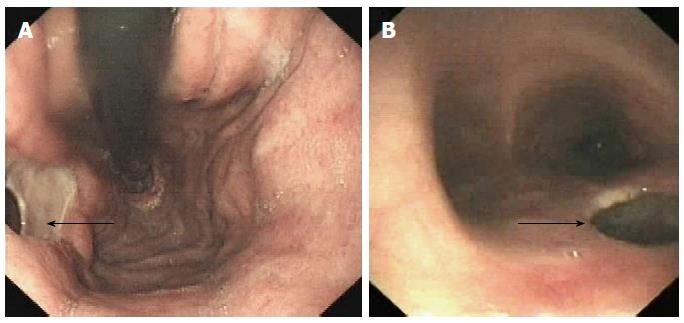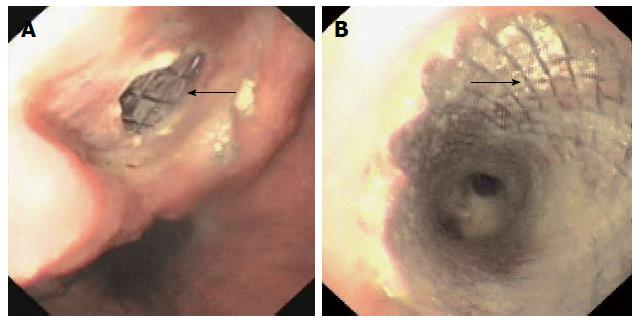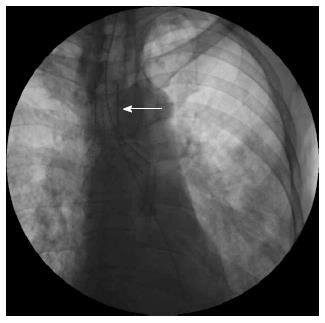Published online Jan 21, 2015. doi: 10.3748/wjg.v21.i3.1032
Peer-review started: April 27, 2014
First decision: May 29, 2014
Revised: June 27, 2014
Accepted: July 24, 2014
Article in press: July 25, 2014
Published online: January 21, 2015
Processing time: 269 Days and 23.7 Hours
A 67-year-old man had a sev-ere cough and pulmonary infection for 1 wk before seeking evaluation at our hospital. He had undergone esophagectomy with gastric pull-up and radiotherapy for esophageal cancer 3 years previously. After admission to our hospital, gastroscopy and bronchoscopy revealed a fistulous communication between the posterior tracheal wall near the carina and the upper residual stomach. We measured the diameter of the trachea and bronchus and determined the site and size of the fistula using multislice computed tomography and gastroscopy. A covered self-expanding Y-shaped metallic stent was implanted into the trachea and bronchus. Subsequently, the fistula was closed completely. The patient tolerated the stent well and had good palliation of his symptoms.
Core tip: Gastrotracheal fistula (GTF), the fistula between the tracheobronchial tree and stomach after gastric pull-up surgery, is an extremely rare complication of esophagectomy and the condition is life-threatening. For these patients, the goal of therapy is palliative rather than curative. During the past decade, metallic airway stents have been used in patients with GTFs. However, fistulas close to the carina often require the placement of Y-shaped stents for successful palliation. We report a patient post-esophagectomy with a GTF near the carina that was successfully treated with a covered self-expanding Y-shaped metallic stent.
- Citation: Wang F, Yu H, Zhu MH, Li QP, Ge XX, Nie JJ, Miao L. Gastrotracheal fistula: Treatment with a covered elf-expanding Y-shaped metallic stent. World J Gastroenterol 2015; 21(3): 1032-1035
- URL: https://www.wjgnet.com/1007-9327/full/v21/i3/1032.htm
- DOI: https://dx.doi.org/10.3748/wjg.v21.i3.1032
A gastrotracheal fistula (GTF), the fistula between the tracheobronchial tree and stomach after gastric pull-up surgery, is an extremely rare complication of esophagectomy and the condition is life-threatening[1]. If a malignant GTF is untreated, the patient will suffer continued tracheobronchial soilage, develop pulmonary sepsis rapidly and die. The average survival of patients with this complication is 1-6 wk with supportive care alone[2]. For these patients, the goal of therapy is palliative rather than curative. During the past decade, metallic airway stents, such as covered self-expandable metal stents (SEMS), have been used in patients with GTFs. Various studies[3,4] involving the use of covered SEMSs or partially covered SEMSs for malignant fistulas have proved that 87%-91% of patients acquire successful fistula closure. Inserting a covered metallic airway stent into the trachea or bronchus has proven to be an effective method to seal off the fistula[5]. However, fistulas close to the carina often require the placement of Y-shaped stents for successful palliation[6]. We report a patient post-esophagectomy with a GTF near the carina that was successfully treated with a covered self-expanding Y-shaped metallic stent.
A 67-year-old man had a severe cough and pulmonary infection for 1 wk before admission to our hospital. He had undergone esophagectomy with a gastric pull-up and radiotherapy for esophageal cancer 3 years previously. After admission to our hospital, gastroscopy revealed a fistula in the upper body of the stomach (Figure 1A) and bronchoscopy confirmed the presence of a fistula in the lower trachea near the carina (Figure 1B). We measured the diameter of the trachea and bronchus and determined the site and size of the fistula using multislice computed tomography (CT) and gastroscopy. A covered self-expanding Y-shaped metallic stent (body, 30 mm × 70 mm; right limb, 14 mm × 30 mm; left limb, 18 mm × 40 mm, Changzhou New District Garson Medical Stent Apparatus Co., Ltd, Changzhou, Jiangsu province, China) was implanted into the trachea and bronchus. Stent insertion was performed fluoroscopically, controlled by flexible bronchoscopy under general anesthesia and jet ventilation. Correct placement was ensured by inserting 2 guide wires in both main bronchi. The 2 bronchial arms of the Y-stent were introduced over the 2 guide wires. Utmost care was taken that these wires did not cross inside the trachea but ran parallel when introducing the stent over these wires. After both bronchial arms opened completely, the tracheal part was released. Subsequently, the fistula was closed completely. After stent placement, gastroscopy (Figure 2A) and bronchoscopy (Figure 2B) confirmed that the Y-stent tightly sealed the fistula. Fluoroscopy also revealed correct placement of the stent (Figure 3). The patient tolerated the stent well and the cough and pulmonary infection improved after the stent placement. However, he died of disease progression with a patent stent 1 mo later.
GTF is an extremely rare complication and can most often be observed after gastroesophageal surgery[1]. GTF may develop because of dissection injury or post-operative mediastinitis in the early post-operative period. GTF occurring in the late post-operative period is most often due to tumor recurrence, radiation necrosis and tracheobronchial erosion along the gastric staple-line[7]. CT scanning can demonstrate the defect between the trachea and the residual stomach. Bronchoscopy and gastroscopy are helpful for the identification and localization of the fistula.
The treatment options for GTF include surgery, external drainage and endoscopic treatment. Surgical repair of the fistula, which includes tracheal resection, lower lobectomy or creation of a muscle flap, may impose an excessive burden on a debilitated patient[2]. Therefore, the use of covered metallic stents is a good choice in the palliative treatment of these patients. Recently, Han et al[8] reported that metallic stent placement for tracheobronchial diseases was technically successful in 96% of patients, with 85% of patients presenting with symptom improvement 1-7 d after stent placement. Furthermore, for the patient with a thermic effect of feeding (TEF), maintaining sufficient ventilation is difficult. Passing the fistula with the bronchoscope and ventilating the patient through the bronchoscope lying distally to the fistula is usually possible without problems in a high TEF. However, in a fistula at the level of the tracheal bifurcation or near the carina, it is not feasible. Thus, jet ventilation is necessary. In our case, stent insertion was performed under general anesthesia with jet ventilation.
However, choosing a stent that will fully cover the fistula and allow sufficient tolerance compression is very important for successful stenting. For the patient described herein, the replaced stomach showed a large lumen compared with the lumen of the original esophagus. Therefore, esophageal stenting was not feasible. After consultation with specialists, we chose the covered self-expanding Y-shaped metallic stent.
The self-expanding Y-shaped metallic stents not only cover the fistula, but also have lower rates of migration because they imitate the bifurcation and attach to the main carina[9]. When the metallic stent is in place, it can expand to fill the space between the stent and the mucosa. The flexibility and radial force enable stents to fit the contours of the trachea or bronchus and make stents well-suited to prevent luminal contents from leaking[4].
However, metallic stents are not as effective against neoplasms and proliferating granulation tissue. One of the Y stent-related complications is the retention of secretions because the cilia cannot function when a covered metal stent is in place. Prevention of these stent-related complications remains one of the major challenges for developing new stent designs.
GTF is a rare but serious complication which is most often encountered after gastroesophageal surgery. The implantation of a covered self-expanding Y-shaped metallic stent proved to be an effective treatment for a GTF.
A 67-year-old man had a severe cough and pulmonary infection for 1 wk before seeking evaluation at our hospital.
He had undergone esophagectomy with gastric pull-up and radiotherapy for esophageal cancer 3 years previously. After admission to the hospital, gastroscopy and bronchoscopy revealed a fistulous communication between the posterior tracheal wall near the carina and the upper residual stomach.
The authors measured the diameter of the trachea and bronchus and determined the site and size of the fistula using multislice computed tomography and gastroscopy.
A covered self-expanding Y-shaped metallic stent was implanted into the trachea and bronchus. Subsequently, the fistula was closed completely.
The patient tolerated the stent well and had good palliation of his symptoms.
In this article, the authors describe the case of a 67-year-old man with a gastrotracheal fistula after an esophagectomy with gastric pull-up, which was conservatively treated by the bronchoscopic placement of a covered self-expanding Y stent.
P- Reviewer: Konishi T, Melloni G, Petronella P S- Editor: Gou SX L- Editor: Roemmele A E- Editor: Liu XM
| 1. | Marty-Ané CH, Prudhome M, Fabre JM, Domergue J, Balmes M, Mary H. Tracheoesophagogastric anastomosis fistula: a rare complication of esophagectomy. Ann Thorac Surg. 1995;60:690-693. [RCA] [PubMed] [DOI] [Full Text] [Cited by in Crossref: 29] [Cited by in RCA: 29] [Article Influence: 1.0] [Reference Citation Analysis (0)] |
| 2. | Reed MF, Mathisen DJ. Tracheoesophageal fistula. Chest Surg Clin N Am. 2003;13:271-289. [RCA] [PubMed] [DOI] [Full Text] [Cited by in Crossref: 198] [Cited by in RCA: 203] [Article Influence: 9.2] [Reference Citation Analysis (0)] |
| 3. | May A, Ell C. Palliative treatment of malignant esophagorespiratory fistulas with Gianturco-Z stents. A prospective clinical trial and review of the literature on covered metal stents. Am J Gastroenterol. 1998;93:532-535. [RCA] [PubMed] [DOI] [Full Text] [Cited by in Crossref: 4] [Cited by in RCA: 4] [Article Influence: 0.1] [Reference Citation Analysis (0)] |
| 4. | Ross WA, Alkassab F, Lynch PM, Ayers GD, Ajani J, Lee JH, Bismar M. Evolving role of self-expanding metal stents in the treatment of malignant dysphagia and fistulas. Gastrointest Endosc. 2007;65:70-76. [RCA] [PubMed] [DOI] [Full Text] [Cited by in Crossref: 94] [Cited by in RCA: 88] [Article Influence: 4.9] [Reference Citation Analysis (0)] |
| 5. | Li YD, Li MH, Han XW, Wu G, Li WB. Gastrotracheal and gastrobronchial fistulas: management with covered expandable metallic stents. J Vasc Interv Radiol. 2006;17:1649-1656. [RCA] [PubMed] [DOI] [Full Text] [Cited by in Crossref: 25] [Cited by in RCA: 30] [Article Influence: 1.7] [Reference Citation Analysis (0)] |
| 6. | Hürtgen M, Herber SC. Treatment of malignant tracheoesophageal fistula. Thorac Surg Clin. 2014;24:117-127. [RCA] [PubMed] [DOI] [Full Text] [Cited by in Crossref: 37] [Cited by in RCA: 45] [Article Influence: 4.1] [Reference Citation Analysis (0)] |
| 7. | Bennie MJ, Sabharwal T, Dussek J, Adam A. Bronchogastric fistula successfully treated with the insertion of a covered bronchial stent. Eur Radiol. 2003;13:2222-2225. [RCA] [PubMed] [DOI] [Full Text] [Cited by in Crossref: 23] [Cited by in RCA: 21] [Article Influence: 1.0] [Reference Citation Analysis (0)] |
| 8. | Han XW, Wu G, Li YD, Zhang QX, Guan S, Ma N, Ma J. Overcoming the delivery limitation: results of an approach to implanting an integrated self-expanding Y-shaped metallic stent in the carina. J Vasc Interv Radiol. 2008;19:742-747. [RCA] [PubMed] [DOI] [Full Text] [Cited by in Crossref: 31] [Cited by in RCA: 29] [Article Influence: 1.7] [Reference Citation Analysis (0)] |
| 9. | Gompelmann D, Eberhardt R, Schuhmann M, Heussel CP, Herth FJ. Self-expanding Y stents in the treatment of central airway stenosis: a retrospective analysis. Ther Adv Respir Dis. 2013;7:255-263. [RCA] [PubMed] [DOI] [Full Text] [Cited by in Crossref: 28] [Cited by in RCA: 30] [Article Influence: 2.5] [Reference Citation Analysis (0)] |











